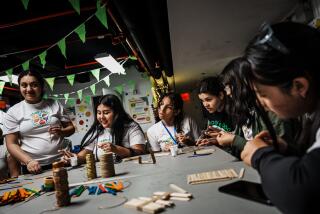Girl Scouts’ Honor : The homeless: Children can join troops at two area shelters where leaders focus on building life skills and self-esteem. Even boys can join the fun.
- Share via
Given a chance to leave a San Pedro homeless shelter for their own rented house this summer, Pam Thornton’s three children begged their mother to stay at the shelter.
Thornton’s daughters, Amber, 7, and Brooke, 4--and yes, even her 5-year-old son, Paul--were having too much fun in a Girl Scouts program at the Harbor Interfaith Shelter. They did not want to miss a thing: not the handmade yarn dolls, the juice and doughnuts or the trip to a South Bay water park.
“They learned a lot about sharing and interacting,” Thornton said. “Before, we lived on the east side of Long Beach. All the kids liked to fight and had real bad language. After three months there, my kids had changed completely. It was hard for me to control them. Now they are much easier for me to handle.”
The new scouting program--at the San Pedro site and at the mid-Wilshire Gramercy Place Shelter--provides crafts, field trips, health and safety training and other activities that its directors hope will build the self-esteem of children who may have never known the pleasures of crayons or paper dolls.
Working with college-age leaders, the children learn the Girl Scout promise, law and history, earn membership pins and strive for badges. When they leave the shelter, the Girl Scouts try to link them with troops in their new neighborhoods.
The Los Angeles effort is an offshoot of scouting programs at shelters in San Jose, Washington, D.C., Philadelphia, White Plains, N.Y., and other locations.
“We always very much try to take Girl Scouts wherever girls live,” said Mary Rose Main, national executive director of Girl Scouts U.S.A. “Today we have more homeless children than ever and we are moving as rapidly as we can to reach them.”
Most of the troops reach out to homeless children in a way that might shock traditionalists: They work with boys as well as girls.
“Normally we think it’s important for Girl Scouts to learn leadership in a single-sex environment where they are comfortable and not competing with boys,” said Judie Borie, executive director of the Greater Philadelphia Girl Scouts Council. “But here you can’t take girls away and make a separate group because often they are caretakers for younger brothers.”
The boys do not become formal members of the organization but participate in most of its activities and, in Los Angeles, are given unofficial badges. Boys age 7 or older at the San Pedro shelter can join the Boys Club of San Pedro.
The Girl Scouts started their Los Angeles programs this summer. “They have worked on a full schedule of scouting activities, but in addition they have worked on empowerment and self-esteem and that is real important with homeless kids,” said Cheri Miller, director of Harbor Interfaith Shelter.
“There is a real message that society is giving kids by allowing them to become homeless and that is that they are not valuable. . . . The Girl Scouts have worked hard to reverse that message.”
Said Marlene Singer, director of Gramercy Place Shelter, “The program provides continuity to children who have had very little. The same leaders are here all five days, so the children develop the ability to have role models and to trust someone.
“The second benefit is the skill-building. It’s subtle because the program is short-term and task-oriented, but they feel a sense of accomplishment and learn skills at the same time: how to play together, how to construct things, and how to problem solve.”
Although the programs are short-term--homeless children typically spend brief periods in shelters--the activities are often more extensive than those found in child-care programs.
The Girl Scouts from the San Pedro shelter visited the Los Angeles Children’s Museum and the Museum of Science and Industry this summer.
On a recent clear morning a dozen children ages 3-14 sat in the shelter’s front yard making button-and-thread bracelets. After a snack of juice and doughnuts, they giggled as they assembled yarn dolls with paper heads and button eyes.
But the day’s real excitement still awaited them. At 11 a.m. a van transported the youngsters to a Redondo Beach water park where they screamed gleefully while careening down a long, twisting slide.
The Scouts held daylong summer sessions for 50 youngsters at the San Pedro shelter and afternoon-only sessions for 35 children at Gramercy Place Shelter. The fall meetings will be from 3-6 p.m. five days a week.
Together, the programs for homeless children, which started in White Plains, N.Y., four years ago and in San Jose a year ago, have reached more than 1,000 area children.
“Every day they are doing something different. They are always making something,” Pam Thornton said about her three children. “They like the staff and they like all the other kids. That is a lot of kids to play with.”
At Gramercy Place, Toya Martin, 24, said her daughter, Brittani, 4, returns from preschool each day and rushes to the Girl Scouts program on the shelter’s patio.
“It allows her to open up and express herself daily through creative activities like arts and crafts or painting and drawing,” Martin said.
“Her artwork shows how she feels. She usually presents bright colors. When we lived on Skid Row she used to color totally dark. And to show her how proud I am, I hang her pictures on my wall. She’s more open. She told me she’s happy. She likes her new house and the facilities where she can play with the Scouts.”
The children are equally enthusiastic.
“Instead of being in our mother’s way and doing bad things we come over here to play,” said Alishia Corell, 11, who brought her 11-month-old sister to the summer meetings at the San Pedro shelter.
“It’s nice because teachers play with us more than other adults. These people don’t yell at us when we do bad things. They just tell us to sit down. They treat us right. Every time after lunch they give us snacks. They give us books and toys.”
Her friend, Aidee Arango, 12, agreed. “These people treat you nice,” she said. “Some people treat you bigger than you are and some people treat you littler. I like to be treated like my age.”
Girl Scout leaders say working with boys and girls of different ages requires flexibility.
“Children in shelters generally seem younger than they are,” Borie said.
“A kindergarten child who has crayons and a few sheets of paper is thrilled to draw a picture without someone snatching the paper out of her hands. She is almost too grateful. These children have no privacy and practically no belongings of their own which do not get stolen.
“What she wants more than anything is a chance to do something on her own that she can be proud of and will get the attention of adults.
“She is not as difficult to deal with as the sixth-grade boy whose theory about relating to his peers is to be destructive. That is how he gets attention.
“These kids have never learned to play together. All they know is, ‘I have to get it fast before someone takes it away from me.’ They need constant activity and a consistent, caring adult.”
At Gramercy Place, James Enriquez, 27, said Scout leaders work well with his daughter Evelyn, 6, and sons Benjamin 9, Rick, 7, Anthony, 3, and Daniel, 2.
The unemployed truck driver said he hesitated to enroll the boys in Girl Scouts, but his concerns have vanished.
“It’s like my children know what time the Girl Scout leaders are coming and they wait for them to come through that door,” Enriquez said, “and when they see them they run to them and hang on to them.
“They have lots of things that they make to keep in their rooms. The leaders take them to the park, to McDonald’s and on little walks through the neighborhoods, which is nice. Everyday they do something different. Then they sit down and talk to the children. They get real proud of what they do.”
More to Read
Sign up for Essential California
The most important California stories and recommendations in your inbox every morning.
You may occasionally receive promotional content from the Los Angeles Times.













